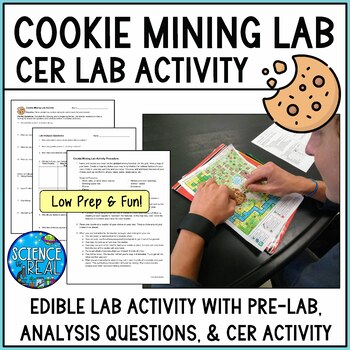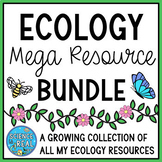Cookie Mining Lab - Natural Resources CER Edible Lab Activity
- Zip
What educators are saying
Also included in
- ⭐ ⭐ ⭐ ⭐ Save money and time with this Ecology Growing Bundle! Get this growing bundle now before more products are added and the price increases! These resources are designed for standard high school or advanced middle school science students. More resources will be soon added as I create new produPrice $234.99Original Price $336.48Save $101.49
- ⭐ ⭐ ⭐ ⭐ ⭐ Save $$$ with this growing collection of edible secondary science lab activities! All included science labs are low prep and use easy-to-find and affordable edible supplies to increase engagement and leave a long lasting scientific impression on your students. Get it now while it is stillPrice $30.04Original Price $42.92Save $12.88
Description
⭐ ⭐ ⭐ ⭐ Fun Hands-On C-E-R! Student model how surface mining impacts the environment with edible ingredients (a cookie!) and write a short CER about the health and environmental impacts of surface mining. Included with the lab handout are pre-lab questions, a step-by step procedure, student directions and map template, analysis questions, and a scaffolded claim, evidence, and reasoning writing activity. Also included in your download is a detailed lesson plan, rubrics, answer key, and differentiated town maps.
Low prep and easy to follow – this lab is sure to be a hit in your classroom!
Students will create a town, mine a cookie with a toothpick, and analyze the effects of surface mining on their town. This editable and edible CER cookie mining natural resources lab uses affordable and easily accessible supplies. Each team or individual student will need 1 cookie and 1 toothpick.
⭐ Topics ⭐
• Surface Mining
• Impacts of Mining
• Renewable and Non-Renewable Natural Resources
• CER in Science
⭐ Lab Overview
- Students will answer 8 pre-lab questions (suggested references handout is included for student support).
- Students will create a town on the provided town map handout. 4 version and an editable version are included!
- Students will place the cookie on their town map and mine their cookie for coal ore using a toothpick
- Students will analyze their lab data and answer post-lab analysis questions
- As a culminating activity, students will work on their own to complete a final short CER activity based on a question prompt about surface mining, human society, and the environment (editable and differentiated rubrics included). Sometimes I assign this last part, sometimes I do not if we are low on time, and sometimes I offer it as extra credit. This is editable as well!
Key Terms: Human Impact on the Environment, Natural Resources, Renewable Resources, Nonrenewable Resources, Surface Mining, Human Health, Environment, Environmental Science, Claim, Evidence, Reasoning, Rebuttal, CER
⭐ What You Will Receive :
• Teacher Lesson Plan with standards, objectives, vocabulary, pacing, procedure, prep, and materials
• Student Lab Handout with procedure, pre-lab questions, post-lab questions, and CER activity (PDF and Editable MS Word)
• Images of student examples
• 3 CER Writing Rubrics- 3 versions included for differentiation (PDF)
• Answer Key (PDF)
⭐ This is available in a money-saving discount growing bundle ! - Edible Science Labs Bundle
Click on the Preview To Learn More!
⭐ Got any questions, requests, or could use a little more insight?
Email me personally! scienceisrealeducation@gmail.com
Science Is Real! Terms of Use (TOU):
By purchasing this product, you own a license for one teacher only for personal use in their own classroom. Licenses are non-transferable and therefore cannot be passed from one teacher to another. If the teacher who purchased this license leaves the classroom or changes schools, the license and materials leave with that teacher. No part of this resource is to be shared with colleagues or used by an entire team, grade level, school or district without purchasing the correct number of licenses. If you are a coach, principal or district interested in transferable licenses that would accommodate yearly staff changes, please contact me for a transferable license quote at ajcatts@gmail.com or scienceisrealeducation.com
Please note - all material included in this resource belongs to Ana Catts. By purchasing, you have a license to use the material, but you do not own the material. You may not upload any portion of this resource to the internet in any format, including school/personal websites or network drives unless the site is password protected and can only be accessed by students, not other teachers or anyone else on the internet.
Purchase of the product is for single classroom use by the purchaser only. It is a violation for individuals, schools, and districts to redistribute, edit, sell, or post this item on the public Internet or to other individuals. Disregarding the copyright is a violation of the Digital Millennium Copyright Act and subject to legal action.
-By purchasing this product you acknowledge that you have read and understood the Terms of Use.
Clipart by the talented (C)Color Idea Clipart and (C)Sarah Pecorino Illustrations
HAPPY SCIENCING!
❤️ CLICK TO FOLLOW SCIENCE IS REAL!
Get News of Sales, New Products, and Discounts!
Connect with Me!
Facebook
Science Is Real Website
TpT Store
❤️ CHECK OUT MORE GREAT THINGS FROM SCIENCE IS REAL! ❤️
⭐ Human Impact On The Environment Webquest - Perfect Earth Day Webquest
⭐ Rock Cycle Webquest with Types of Rocks - Editable MS Word, Google, & PDF
⭐ Rock Cycle 5E Unit Plan - Secondary Science
⭐ Rock Cycle Board Game with Question Cards!
⭐ Rock Cycle Stations Lab Activity - Student Led Lab Stations
⭐ Minerals Webquest - Digital and Printable
⭐ Climate Change 5E Unit Plan - Secondary Science
⭐ Climate Change CER Literacy and Graphing Lab Activity
⭐ Climate Change Stations Lab - Student-Led Climate Change Stations
⭐ Climate Change Webquest - Digital and Printable
⭐ Volcanoes Lab - Types of Volcanoes Edible CER Lab - Low Prep and Fun!
⭐ Modeling Mitosis with Cookies Lab Activity
⭐ Plate Tectonics Lab - Modeling Plate Boundaries and CER Lab Activity







